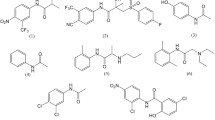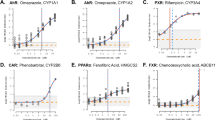Summary
Before their use as a source of carcinogen-activating enzymes in the hamster embryo cell transformation assay, liver, kidney, lung, and small intestine S9 fractions from Syrian golden hamsters and Sprague-Dawley rats were evaluated for toxicity to hamster embryo target cells. Sprague-Dawley rat liver and kidney S9 were highly toxic to the hamster embryo cells (90 to 100%). When retested at lower concentrations these tissue fractions were still quite toxic (up to 75%). In contrast, hamster liver and kidney S9 were considerably less toxic (14 to 25%). The S9 preparations were also evaluated for their ability to metabolizeN-2-acetylaminofluorene to 2-aminofluorene andN-hydroxy-acetylamino-fluorene, products that transform hamster embryo cells. Large amounts ofN-hydroxy-acetylaminofluorene were formed in the presence of preparations from hamster liver and small intestine, whereas kidney and lung S9 fractions were considerably less active. No detectable levels ofN-hydroxy-acetylaminofluorene were formed after incubation ofN-2-acetylaminofluorene with any of the rat S9 preparations. High levels of deacetylase activity were found in hamster liver and small intestine S9 fractions, at least eightfold higher than those obtained from equivalent rat preparations. Hamster kidney and lung S9 fractions showed low levels of deacetylase activity. There was no detectable activity in equivalent preparations from rats. When tested withN-2-acetylaminofluorene in the hamster embryo cell clonal transformation system, transformed colonies were obtained with hamster liver S9, with and without an external NADPH-generating system.
Similar content being viewed by others
References
Ames, B. N.; McCann, J.; Yamasaki, E. Methods for detecting carcinogens and mutagens with theSalmonella/mammalian microsome mutagenicity test. Mutat. Res. 31: 347–363; 1975.
Bartsch, H.; Malaveille, C.; Camis, A. M.; Martel-Planche, G.; Brun, C.; Hautefleville, A.; Sabadie, N.; Barbin, A. Validation and comparative studies on 180 chemicals withS. typhimurium strains and V79 hamster cells in the presence of various metabolizing systems. Mutat. Res. 76: 1–50; 1980.
Poiley, J. A.; Raineri, R.; Pienta, R.J. The use of hamster hepatocytes to metabolize carcinogens in anin vitro bioassay. J. Natl. Cancer Inst. 63: 519–524; 1979.
Poiley, J. A.; Raineri, R.; Andrews, A. W.; Cavanaugh, D. M.; Pienta, R. J. Metabolic activation by hamster and rat hepatocytes in theSalmonella mutagenicity assay. J. Natl. Cancer Inst. 65: 1293–1298; 1980.
Raineri, R.; Poiley, J. A.; Andrews, A. W.; Pienta, R. J.; Lijinsky, W. Hepatocyte and S9-mediated activation ofN-nitroso compounds to metabolites mutagenic toSalmonella. J. Natl. Cancer Inst. 67: 1117–1122; 1981.
Selkirk, J. K. Divergence of metabolic activation systems for short-term mutagenesis assays. Nature 270: 604–607; 1977.
Bigger, C. A.; Tomaszewski, J. E.; Dipple, A. Differences between products of binding of 7,12-dimethylbenz(a)anthracene to DNA in mouse skin and in a rat liver microsomal system. Biochem. Biophys. Res. Commun. 80: 229–235; 1978.
Raineri, R.; Hillesund, T.; Ernst, M. K.; Cavanaugh, D. M.; Poiley, J. A. Metabolic activation, detoxification and transformation studies with benzo(a)pyrene using rat and hamster organ cellsin vitro. J. Appl. Toxicol. 3: 196–202; 1983.
Poiley, J. A.; Ernst, M. K.; Cavanaugh, D. M.; Raineri, R. Use of the hamster embryo cell transformation assay to detect metabolic activation by intact organ cells. J. Appl. Toxicol. 3: 326–331; 1983.
Lowry, O. H.; Rosebrough, N. J.; Farr, A. L.; Randall, R. J. Protein measurement with the Folin phenol reagent. J. Biol. Chem. 193: 265–275; 1951.
Raineri, R.; Poiley, J. A.; Ernst, M. K.; Hillesund, T.; Pienta, R. J. A high pressure liquid chromatography procedure for the separation of metabolites of 2-acetylamino-fluorene from cells in culture. J. Liquid Chromat. 1: 457–467; 1978.
Pienta, R. J.; Poiley, J. A.; Lebherz, W. B., III. Morphological transformation of early passage golden Syrian hamster embryo cells derived from cryopreserved primary cultures as a reliablein vitro bioassay for identifying diverse carcinogens. Int. J. Cancer. 19: 642–655; 1977.
Curren, R. D.; Kouri, R. E.; Schechtman, L. M. Studies on metabolic activation of chemicals for mammalian cell transformation and mutagenesis. Mishra, N.; Dunkel, V.; Mehlman, M., eds. In: Advances in modern environmental toxicology-mammalian cell transformation by chemical carcinogens. Princeton Junction, NJ: Senate Press, Inc.; 1981:319–353.
Anders, M.; McCoy, E. C.; Rosenkranz, H. S.; Zeiger, E. A bactericidal activity of microsomal preparations. Mutat. Res. 78: 1–5; 1980.
Author information
Authors and Affiliations
Additional information
This work was supported by Contract N01-CO-75380 with the National Cancer Institute, NIH, Bethesda, MD 20205.
Rights and permissions
About this article
Cite this article
Poiley, J.A., Raineri, R. Species specificity affects the choice of S9 preparations for use in the hamster embryo cell transformation system. In Vitro 20, 602–606 (1984). https://doi.org/10.1007/BF02619608
Received:
Accepted:
Issue Date:
DOI: https://doi.org/10.1007/BF02619608




